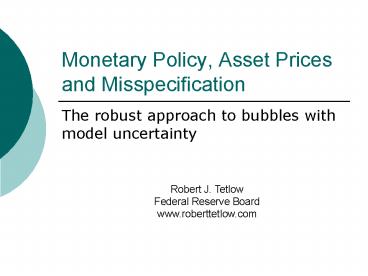Monetary Policy, Asset Prices and Misspecification
1 / 27
Title:
Monetary Policy, Asset Prices and Misspecification
Description:
The views expressed in this presentation and in the paper this presentation is ... Then consider the uncertainty-averse robust response to possible misspecification ... –
Number of Views:22
Avg rating:3.0/5.0
Title: Monetary Policy, Asset Prices and Misspecification
1
Monetary Policy, Asset Prices and Misspecification
- The robust approach to bubbles with model
uncertainty
Robert J. Tetlow Federal Reserve
Board www.roberttetlow.com
2
Disclaimer!
- The views expressed in this presentation and in
the paper this presentation is based upon are
those of the author alone and are not necessarily
shared by any member of the Board of Governors or
its staff.
3
Motivation
- Observation bubbles are often followed by
economic underperformance - U.S. stock market boom and bust (1929-33)
- Japan real estate bubble (1986-1995)
- U.S. tech stock boom and bust (1997- 2002)
4
(No Transcript)
5
In theory
- if bubbles matter'...
- Control theory says feed back on everything
- Uncertainty is just a signal-extraction problem.
- But
- Inflation forecasts can encompass a lot of
information, so reacting to asset prices might
not be necessary. - Non-linear, non-Gaussian processes could point in
either direction, particularly given uncertainty - Historical experience argue for humility.
6
The debate
- The majority view is no
- a policy maker that looks ahead, responding to
the implications everything for future inflation,
but should place no added emphasis on bubbles.
(Bernanke-Gertler) - The minority view is yes
- policy makers can, should and do deal with
bubbles, not by targeting asset prices as such,
but by responding to them in reflection of their
episodic role in transmitting crises. (Cecchetti
et al.)
7
Partial list of references
- policy references
- Batini and Nelson (2000), Bernanke and Gertler
(1999,2001), Bullard and Schaling (2002),
Cecchetti et al. (2000, 2002), Cochrane (2002),
Cogley (1999), Filardo (2001), Gilchrist and
Leahy (2002), Kent and Lowe (1997), Mishkin and
White (2002), Reinhart (1998). - robust control references
- Giannoni (2002), Hansen and Sargent (various),
Onatski (2001), Onatski and Stock (1999), Rustem
(1988), Rustem et al. (2002), Stock (1999),
Tetlow-von zur Muehlen (2001,2002)
8
Methodology
- Take a model that is conventional, except that
financial markets matter - Subject it to a process of bubbles in stock
prices - Compute the optimal response in
inflation-forecast based (IFB) rules, and
outcome-based (Taylor-type) policy rules, with
and without a stock-price term. - Then consider the uncertainty-averse robust
response to possible misspecification - Examine the costs of protecting against
uncertainty
9
The model
- Begin a version of BGG (1997), a standard NKB
model except - It has capital
- There are financial frictions
- Hybrid NK price equation
- Consumption depends on observed stock prices
- A bubble process for stock prices
10
The model (continued)
- And we go further. We also add
- Habit persistence in consumption
- Generalized adjustment costs in investment
- Investment that depends on observed stock prices
11
Modeling bubbles
12
(No Transcript)
13
(No Transcript)
14
(No Transcript)
15
Methodology
- Formulate the state-space form
- Loss function
16
Methodology (continued)
- Simple rules
- Note that rule can be outcome based (j0), or
forecast based (j1). - Note also that the policy rule has no error term.
- Constants are normalized to zero.
17
Robust policy
- Takes uncertainty seriously
- Non-parametric in nature
- Three different variants exist.
- We use structured perturbation method in this
paper. - A malevolent nature is assumed to choose either
a or p within some bound to maximize the loss
function
18
Robust policy (continued)
- More generally, some element of either C or B in
the state-space form, call it bij is chosen
- Subject to the model, the rule and any
restrictions on its specification and the
variance-covariance matrix of shocks.
19
Results 1 the basics
20
Results 1 the basics (continued)
21
Results 2 correlated shocks
22
Results 3 continuation probabilities
23
Results 4 bubble magnitudes
24
Results 5 Robust results
25
Results 6 Robust results
26
Concluding remarks
- What we did
- Examined the role for monetary policy in
responding directly to stock market bubbles - Did so working in three directions
- The breadth of the BG argument
- Broadened the experiments
- Looked at Knightian uncertainty
27
Concluding remarks (continued)
- What we found
- Results are mostly supportive of the majority
view that policy should not respond directly to
bubbles. - However there are calibrations for which the case
for direct response is stronger.































